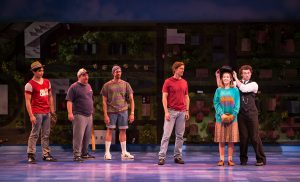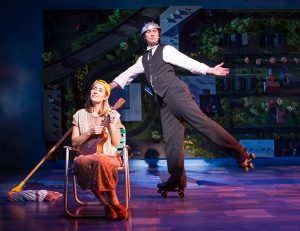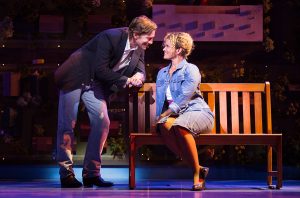Globe’s ‘Benny & Joon’ Spreads Warmth, Love and Some Slapstick
As I understand the new musical Benny & Joon at the Old Globe Theatre, Benny is the one with the problem, not his younger sister Juniper (Joon). Yes, everybody understands that she’s moody and probably schizophrenic, but maybe there’s a reason for some of that. Maybe Benny needs her to be a full-time care job.
Benny’s a lovely guy, respected and even cherished by all who know him at least partly because he’s so quick to share himself with anybody needy. A few bucks, a supportive word, playing along with a fragile self-image, just being there: That’s our Benny.
He’s so quick to place everybody else’s needs before his own that it makes me wonder if he’s some kind of responsibility addict. He’s gotta always have that rush that comes from knowing he helped.

The cast of Benny & Joon at the Old Globe Theatre includes, left to right, Paolo Montalbano, Jason SweetTooth Williams, Colin Hanlon, Andrew Samonsky, Hannah Elless and Bryce Pinkham. Jim Cox Photo
There’s a 1993 movie out there of the same name that I’ve never seen (or even heard of, actually) that caused some controversy over its treatment of mental illness. Fine, but the show I saw at the Globe takes the sensible stance that, to paraphrase a line from the script, Joon is pretty normal except for the occasional oddness. And much of that may be due to the bubble her brother has built around her since the death of their parents in a car crash a dozen years earlier.
The journey of Kirsten Guenther’s book for this musical is a gentle voyage of self-discovery for more than one character but none come as far as Benny. In a reprise of the title song, one of several gentle, germane ballads by Nolan Gasser and Mindi Dickstein, he finds a new sphere of reality, bursting with possibilities. It’s a moment worth all the anticipation.
What’s really nice about this piece so far – and it does need more tinkering despite its already long list of development efforts – is the sweet, refreshed normality of its texture. There are quirks aplenty among these people but nothing that can‘t be worked out. Acid drips elsewhere. Here in Spokane of the early 90s, people can figure out how to cope and even find some happiness.
So the trio of guys who work for Benny at his auto-repair shop might be written off as losers, except they care too much, about him and his feelings for Joon. The waitress at the neighborhood lunch-counter, enjoying her last years of cute before settling into mature, is sunny and feminine without visible regrets. Even Joon’s shrink, though orthodox, knows when to back off. If tolerance and respect count, this is a low-medium paradise.
Except for this Benny thing. Joon calls the shop a lot, with concerns as cryptic as they are intrusive. Shrugs and smiles. A handsome guy with no outside life, Benny really is taken with the waitress but…the phone rings again. And what night have been an actual date gets cancelled because yet another hired caretaker has quit in frustration.
Help begins with the arrival of another odd bird from a different cage. Sam is an unwelcome cousin dropped on one of the shop guys and passed on to the care of – who else? – Benny, sight unseen. Maybe a good thing because when Sam shows up, he’s, well, he sure looks and acts like… Buster Keaton.
So the authors have taken a deep breath and hoped that the immortal poker-faced silent film comic will be at least somewhat recognizable decades after he ruled, with Charles Chaplin and Harold Lloyd, Hollywood slapstick.
For me, this works great. Impeccably costumed down to the socks and vest by designer Dane Laffrey, this Sam is mostly mute except for lines from old movies, delivered in soft parody style complete with title and date. He’s modest, polite, undemanding and as unobtrusive as somebody dressed as Buster Keaton in 1990s Spokane could be.
With much less fuss that one might expect, he fits right in. He makes cheese sandwiches with a steam iron and popcorn in the dishwasher. He recognizes the waitress instantly from her tiny bit part in a failed Hollywood horror film of many years ago.
And he turns out to be such a tonic for Joon that soon she’s skipping her meds and inviting Sam to help her with her paintings.
The moment when a play’s plot shape begins to focus can happen anytime; the resolution is best deferred. Thus we in the audience, for whom the path to the happy ending seems obvious, can only hope. More than a few fingers were crossed, I suspect.
The loose ends have mostly to do with backstory. From whence cometh this Sam? Old movies were a refuge, he suggests. OK, but the source of all those movies? The reason he was cut off? And that outfit!
Sam gets a job in a video rental shop. (Remember those? With the clunky black cartridges? Not quite as ancient as Buster but getting there…) What happens thereafter? The proprietor seems a candidate for makeover, bucking up, desertion or something. Yet the subject is dropped.
That’s the thing with a script as engaging as this one: We’d maybe like to know a little bit more about these 10 people. The songs help a lot – rare these days are scores so useful in the actual storytelling – and the fragments of bio are telling. But consideration should be given to either less or more.
I would not want to seriously shake up this warm world evoked by the careful staging of Jack Cummings III, who can lead us where we need to look and give characters room to emerge. Dane Laffrey’s scenic concept – a drone’s-eye view of a suburban neighborhood scrimmed by R. Lee Kennedy’s lighting dexterity and populated by one discrete treadmill with numerous smooth-rolling units of furniture – makes the show sail along easily until, bathed in Kennedy’s Magritte blue, it seems ready to float to another level.
I’m never much good with specifics from the first hearing of a new score, but the Gasser-Dickstein songs seem to me throwback in effect but timeless in style. There is a rousing number for the boys – “Home Run Kings” – which comes as close to raunch as anything in the show (and makes good use of Scott Rink’s choreography) and some rueful musings on wrong roads taken – “Been There, Done That” – for the waitress. But the best stuff goes to Sam – “I Can Help” and “In My Head” – and the siblings, especially that title tune, which flirts with cuteness but stays tough.
Andrew Samonsky is a manly and admirable Benny, seriously respectable from the moment of contact, whereas Hannah Elless is mercurial, quirky and intensely frustrated as Joon. A valuable asset to the project is the deep family connection they provide.
Paolo Montalban, Jason SweetTooth Williams and Colin Hanlon are the jolly and supportive shop guys and January LaVoy is delectably sane and desirable as the waitress. Natalie Toro splits duty as the shrink and a fed-up caretaker.
The performance that will be remembered, however, is Bryce Pinkham’s Sam. Even his haircut is exactly right as he evokes Keaton and a host of other great clowns from the years when vaudeville segued into movies. Pinkham’s vocal choices are almost as hypnotic as his physical control and grasp of physical comedy, which is saying a lot. The hat bits alone earn the paycheck.
Music director J. Oconer Navarro is part of the tight octet in the pit blessed with the luxury of Michael Starobin arrangements and probably deserves credit for the excellent choral sound.
What makes this an important piece of work, though, is the haze of love and caring that envelops it and helps it raise the natural and normal into the sublime.
(Continues at the Old Globe Theatre Tuesdays, Wednesdays and Sundays; at 8 p.m. Thursdays-Saturdays; and at 2 p.m. Saturdays and Sundays through Oct. 22, 2017.)

Welton Jones has been following entertainment and the arts around for years, writing about them. Thirty-five of those years were spent at the UNION-TRIBUNE, the last decade was with SANDIEGO.COM.





Great review, thanks!